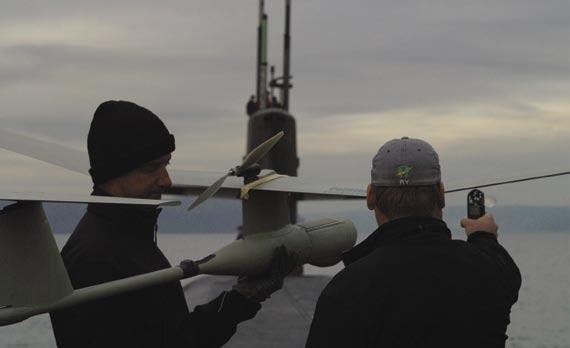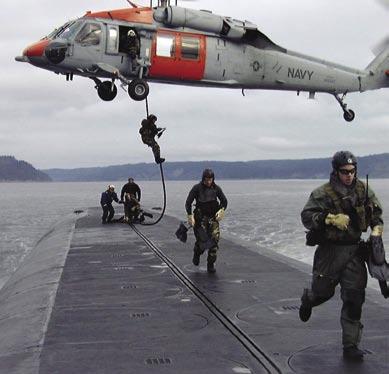
6 minute read
Features
JOINT SPEC OPS: Air Force, Navy Test Rescue Scenario Air Force, Navy Test Rescue Scenario
A U.S. fighter pilot has been shot down. He is injured and behind enemy lines, but he has estab lished communications and is evading the enemy. Time is a critical factor. He needs to be rescued, and he needs to be rescued now . Submerged off the coast, 19,000 tons of stealth in the form of an Ohio -class SSGN submarine lies waiting. It’s equipped with operation al equipment and storage to support over 60 Special Operations Forces (SOF). Notice it reads SOF, not just Navy Special Warfare (SEALs). This is a joint plat form that caters to all SOF warriors from all services. And if all else fails, it has over 150 Tomahawk mis siles at its disposal that can be precision guided down Main Street and right into Mr. Bad Guy’s living room. Talk about surround sound.
Advertisement
(left) Air Force special operations troops prepare to launch an inflatable boat from the deck of USS Alabama ( SSBN-731) .
(right) The sail of Alabama as seen through night vision equipment.
A team of operators from an Air Force Special Tactics Squadron (STS) is sta tioned nearby. They receive word that their unique services are needed. ParaRescue Jumpers (PJs) are trained emer gency medical technician special operators capable of jumping into a combat zone and rescuing personnel from any environ ment. They’ll be joined by their Combat Controller teammates, who jump in with them to control air power at the objective and provide all command, control, and communications for the clandestine team’s missions. Together, with their comrades, the Special Operations Weathermen, they form a unique and versatile team within the joint SOF community: the Air Force Special Operations Command’s Special Tactics Squadron.
In this particular mission, the STS oper ators will fly out to meet the submarine aboard a Navy search and recovery heli copter. They’ll drop onto the slippery deck by fast-roping from the helicopter. Then, the Airmen will go below with their gear to set up for the rescue mission.
The submarine goes back under the water and moves closer to the shoreline. From there, the STS team will leave the submarine after pulling all their gear, boats, and engines through one of the sub’s hatches, inflate their boats, and zoom in to the shore. The plan calls for meeting the downed pilot, treating his injuries, and zooming back out to sea for a complex rendezvous with the sub.
It’s scenarios like these that require cooperation among the services. It also

U.S. Navy Photo
Photo by Master Chief Petty Officer (SS) Daniel J. Niclas

requires practice to iron out the wrinkles in the process. That is where USS Alabama (SSBN-731) stepped up to provide a practice platform for the Air Force’s 22nd and 23rd Special Tactics Squadrons. The Airmen spent November 11-18 aboard the submarine practicing various scenarios in which their services would be required. Alabama is an Ohio-class Fleet Ballistic Missile Submarine, and served as a surrogate for the SSGN.
The goal of the exercise was to test concepts being worked into the SSGN program, such as the rescue scenario described above. Another test successfully accomplished was the first-ever launch and recovery of a UAV from a submarine, according to Lt. Tyler Johnson, Attack Weapons Systems Officer at Commander, Submarine Squadron NINETEEN. Johnson helped coordinate the exercises between Alabama and the Air Force.
“We had four goals for this exercise,” said Johnson. “The first was to further define tactics, techniques, and procedures for the SSGN program. Second, we wanted to prove and expand on our joint interoperability. We also wanted to provide the Air Force with an opportunity to conduct amphibious training with a unique naval resource. Also, we wanted to give the crew of Alabama an opportunity to conduct SOF training,” he said.
Exercises were conducted day and night, offering different environments to challenge the STS operators and Alabama’s crew.
“This was a great opportunity for some of our younger troops to train with their joint counterparts and have an impact on the evolving SSGN program,” said Lt. Col. Mike Sneeder, Commander, 22nd STS, McChord Air Force Base, Wash. “But it was a challenge fast-roping onto the slippery decks and learning to maneuver on the submarine.” His teams also gained some appreciation for the submariners’ lives onboard their boat. “One of the things we had to figure out was how to get our boats, engines, and gear down the hatches and stowed on the submarine in such a limited space,” he noted.
Sneeder talked about lessons learned regarding the UAV launch and believes it has a future aboard SSGNs. “The UAV is definitely another SOF asset that can be launched from this platform. We were able to identify some areas that needed improvement, which was the whole reason we were there – to define areas of process improvement to help make the SSGN the platform it is meant to be,” he said. Sneeder’s teams also benefited from the opportunity to learn from the submariners. “The more we learn and are exposed too, the more effective we’ll be in different mission profiles,” he added.
Alabama’s crew impressed the SOF operators with their professionalism. “It takes a very professional and patient crew to work through the kinks in these brand new tactics with us. Because of their outstanding professionalism, we were able to accomplish more than we had originally set up to do,” Sneeder said. The extra training tested other capabilities, such as recovering inflatable boats on the submarine, and it saved money by packing more training into the limited amount of time already allotted.
The crew of the submarine enjoyed hosting the STS teams and learned from them
(left) Special operations troops prepare to launch a UAV from the deck of Alabama . The UAV can be used to provide security for the submarine or provide reconnaissance for the deploying forces.
as well, according to Lt. Donta Tanner, Supply Officer for the boat. “They are very professional and a lot of fun to work with. I’m glad we had the chance to participate in this exercise and train with the Air Force,” he said. The exercise served to demonstrate SSGN capabilities and prove the joint capability of the program. As the Navy moves into more littoral operating areas, the ability to operate jointly with the other services will play a more dominant role in the Navy’s future. This is a future the Air Force looks forward to being a part of, noted Sneeder. “Our mission statement since 9/11 is to support the Global War on Terror, and the SSGNs will enable us to train and mix with the other SOF opera tors to bring air power to the objective from a submarine.”
Petty Officer Howlett serves as the assistant public affairs officer for COMSUBGRU-9.

Photo by Master Chief Petty Officer (SS) Daniel J. Niclas US Navy photo

(above) Air Force SOF remove their gear through Alabama ’s hatch in preparation for a night exercise.
(left) Air Force special opera tions troops from the 22nd and 23rd Special Tactics Squadrons fast rope onto the deck of USS Alabama (SSBN-731) during a recent exercise to test the capabilities of the SSGN class submarines entering service this year. The SSGN class sub marines are being converted from the same hull type as Alabama , which played the part of an SSGN during the exercise.







